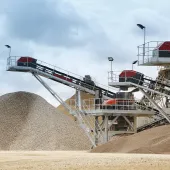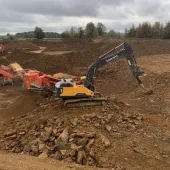Fixing Britain’s housing shortage

First published in the February 2018 issue of Quarry Management
Moreton Cullimore, managing director of the Cullimore Group, champions the role of aggregates and calls for greater government support for the industry
As one of the UK’s most prominent and well-established aggregate providers, the Cullimore Group are calling on the Government for greater support for the aggregates industry, if it is to help build the 300,000 new homes a year pledged by Chancellor Philip Hammond in his Autumn Budget speech. The move comes amid growing industry concern about the huge reality gap that exists between what the Government is promising and what is actually happening on the ground.
The Cullimore Group, based in Whitminster, Gloucestershire, are questioning the Government’s commitment to solving the housing issue, given its apparent complacency about the availability of aggregate volumes and current planning processes. The 90-year-old family firm says this is a point being echoed by the British Aggregates Association (BAA), following its scrutiny of the Government’s ‘Housing White Paper’, released for consultation in 2017, and in particular its alarm at the complete absence of any reference to the critical contribution of aggregates supply in meeting government plans to boost housing stocks – aggregates and minerals being vital in the supply of materials for both house building and the groundworks necessary for housing developments.
Such apathy worries Cullimore Group’s managing director, Moreton Cullimore, who believes it is widespread throughout not just central government, but local authorities too: ‘There seems to be a high degree of complacency about what is potentially available for extraction and what is actually available,’ he said. ‘Just because mineral deposits are located within a council’s designated area of preferred search, that doesn’t mean they will ever be released or realized. Councils need to get away from thinking, it’s ok, we’ll always have another site available to extract aggregates when we need them, as that time may never come.’
Worse still, says Mr Cullimore, there are many other pressures compounding the availability and ability to extract aggregates and minerals from the ground. One such issue is that of mineral landbanks held by landowners. Some county councils, such as Worcestershire CC, are trying to do more to target landowners and boost material supplies for the construction industry, including sand, gravel, clay and hard rock. But unless they have strong enough incentives to sell, most landowners will prefer to keep their minerals locked underground.
Also, current planning rules are complicated, which is why many builders are sitting on banks of land with permission to develop, but are not doing so. And Philip Hammond’s overdue request in asking Sir Oliver Letwin MP to head up an enquiry to resolve this, is regarded as being a bit too little, too late. But even if the regulations are eased for those wanting to build, no similar assurances have been offered for the aggregates industry.
Presently, landowners who do choose to sell typically face a raft of planning checks, including archaeological, arboricultural, wildlife and hydrological surveys that need to be carried out before permission to extract minerals can be granted. In contrast to the Government’s much-publicized 18-month time frame, this can actually take up to five years, with four years planning and a further 12 months dealing with pre-commencement conditions set by the council before any ground preparation can commence.
According to the Mineral Products Association, the Government in 2015 implemented a ‘Cutting Red Tape’ review of mineral extraction, but this stalled despite early progress with government, industry and regulators. Consequently, issues around planning permission and the often-disproportionate bias towards pressure groups, such as the Green Alliance and the Campaign to Protect Rural England (CPRE), all too frequently conspire to thwart a rapid planning process.
Peter Huxtable, secretary of the BAA, is keen to emphasize this point: ‘The Government should take greater care when affording special protection to sites,’ he said. ‘Reviewing their latest Housing White Paper, we were concerned to see ‘Plantations on Ancient Woodland Sites’ (PAWS) given the same level of protection as ‘Ancient Woodlands’. This is despite many of these plantations containing only commercial coniferous woodlands, as encouraged by government policy in the 1950s. It’s unnecessary red tape such as this which is so damaging to the availability and supply of aggregates.’
Both the Cullimore Group and the BAA believe that the Government and local councils could be doing much more to reduce these pressures. According to Mr Cullimore, there needs to be a reality check and a greater sense of urgency about what is happening at ground level. ‘By increasing incentives for landowners and shortening the planning time frames involved, government could help boost the volume of aggregates available for the construction industry and therefore speed up the building of new homes,’ he said.
Moreover, whilst Brexit is currently one of UK’s major preoccupations, Mr Cullimore thinks it could potentially bring benefits to the aggregates industry in terms of mineral availability. He believes that if, following Brexit, the UK decides to leave the Common Agricultural Policy, there could potentially be more land available for development.
‘Currently, there’s a huge disparity between what the Government is communicating about housing and the reality of what we’re seeing with natural resources. Brexit could be a very good opportunity for the aggregates industry, but only if we solve the other issues holding it back first,’ he said. ‘We want to help the Government, but first it needs to do more to support our industry. This is no time for complacency. The Government must act now, if it is to meet Philip Hammond’s ambitious target for fixing the housing shortage.’
- Subscribe to Quarry Management, the monthly journal for the mineral products industry, to read articles before they appear on Agg-Net.com








